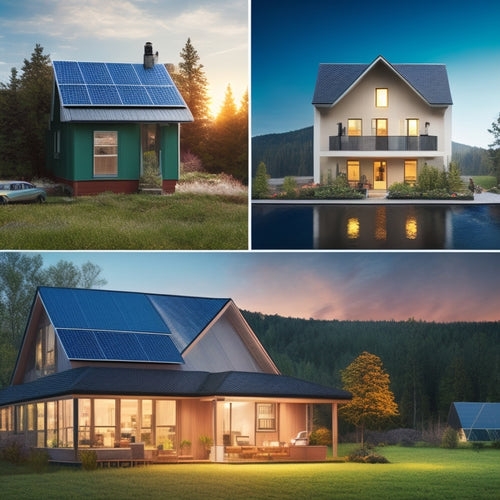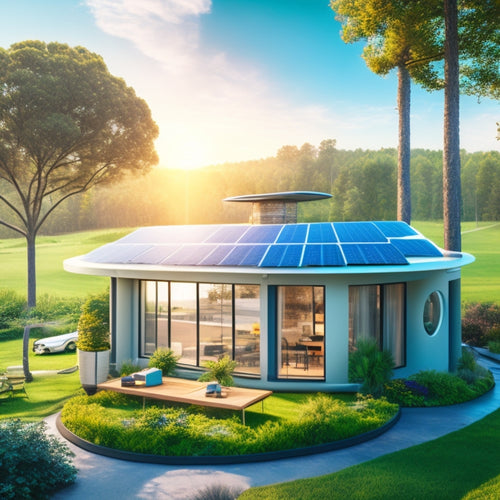
DIY Home Greywater Systems: Top 5 Solutions Explained
Share
You're exploring DIY greywater systems to reduce your potable water consumption. You've got five effective solutions to evaluate: greywater diversion systems that redirect wastewater for irrigation, DIY wetland filtration methods that utilize natural purification powers, greywater irrigation networks for efficient distribution, natural treatment pond systems that employ microorganisms and plants, and greywater recycling tanks for storing treated water. Each option has its benefits, from reducing your water footprint to increasing energy independence. As you weigh your choices, you'll want to probe deeper into the details of each solution to find the best fit for your home and needs.
Key Takeaways
- Grey water diversion systems are a cost-effective way to reuse wastewater from sinks, showers, and washing machines for irrigation.
- DIY wetland filtration methods utilize natural purification powers of plants and microorganisms to treat greywater, reducing water footprint.
- Greywater irrigation networks efficiently distribute treated greywater to specific areas, increasing irrigation efficiency and reducing potable water consumption.
- Natural treatment pond systems employ natural filtration processes to purify greywater through anaerobic, aerobic, settling, oxidation, and polishing ponds.
- Grey water recycling tanks store treated greywater for reuse in irrigation and toilet flushing, reducing water bills and mitigating fuel price volatility.
Grey Water Diversion Systems
Frequently, homeowners who invest in DIY greywater systems opt for grey water redirecting systems as a cost-effective and efficient way to reuse wastewater. These systems divert greywater from your household's sinks, showers, and washing machines to irrigate your surroundings, reducing your potable water consumption.
Additionally, integrating solar-powered charging solutions can further reduce your carbon footprint and energy costs. By leveraging renewable energy sources, you can create a more sustainable and eco-friendly grey water diversion system.
To guarantee compliance with greywater regulations, you'll need to design your system to prevent cross-connection with potable water supply lines. Regular system maintenance is vital to prevent clogs, backups, and contamination.
You'll need to inspect and clean your system regularly, checking for signs of wear and tear on pipes and fittings. By doing so, you'll enjoy the benefits of a well-functioning grey water diversion system while minimizing your environmental footprint.
DIY Wetland Filtration Methods
One effective way to treat greywater is through DIY wetland filtration methods, which employ the natural purification powers of plants and microorganisms to break down contaminants and pollutants.
By creating a constructed wetland in your backyard, you can exploit the filtration benefits of these natural systems to purify your greywater. Implementing sustainable fuel options, such as biodiesel blends, can also contribute to a greener approach.
This method involves directing greywater into a specifically designed area, where it flows through a series of plants and microorganisms that remove impurities and contaminants. As the water flows through the system, it's filtered and purified, making it suitable for irrigation and other non-potable uses.
With a DIY wetland filtration method, you can reduce your water footprint, create a sustainable and eco-friendly solution, and enjoy the freedom to manage your own water resources.
Greywater Irrigation Networks
After employing the power of DIY wetland filtration methods, you can take the next step in greywater management by designing and implementing a greywater irrigation network. This distribution system allows you to efficiently leverage greywater benefits by directing treated water to specific areas of your surroundings.
By doing so, you'll increase irrigation efficiency and reduce your potable water consumption. Incorporating renewable energy solutions, such as solar energy implementation, can further enhance the sustainability of your greywater system. Additionally, adopting hybrid electric solutions can lower emissions and improve fuel efficiency in your water management operations.
A well-designed network guarantees that greywater is distributed evenly, minimizing the risk of over-saturation and erosion. You can use a combination of pipes, pumps, and valves to create a customized network that suits your area's unique needs.
Natural Treatment Pond Systems
Beyond the wetland filtration methods, you can opt for natural treatment pond systems to further purify greywater in your DIY home greywater setup. This approach employs natural filtration processes to maintain ecological balance. By creating a series of ponds, you can leverage the power of microorganisms, plants, and sunlight to break down organic matter and remove contaminants from greywater.
| Pond Type | Function | Key Features |
|---|---|---|
| Anaerobic Pond | Breaks down organic matter | No oxygen, high microbial activity |
| Aerobic Pond | Removes nitrogen and phosphorus | Oxygen-rich, aquatic plants |
| Settling Pond | Removes suspended solids | Calm water, sedimentation |
| Oxidation Pond | Removes remaining pollutants | Aeration, oxygen-rich |
| Polishing Pond | Final clarification and disinfection | Algae control, UV exposure |
Grey Water Recycling Tanks
You've successfully implemented natural treatment pond systems to purify your greywater; now, it's time to contemplate incorporating grey water recycling tanks into your DIY home greywater setup.
These tanks serve as a holding area for treated greywater, allowing you to store and reuse it for irrigation, toilet flushing, or other non-potable purposes. Achieving energy independence mitigates volatility in fuel prices, and with greywater recycling tanks, you can also reduce your water bills.
When selecting a recycling tank, verify it meets local greywater regulations and can handle the volume of greywater your system produces.
Regular tank maintenance is vital to prevent sediment buildup and bacterial growth. Perform routine inspections, clean the tank as needed, and monitor water quality to confirm a safe and efficient greywater recycling system.
Frequently Asked Questions
Can I Use Greywater for Flushing Toilets and Running Washing Machines?
You can employ greywater for flushing toilets and running washing machines, reaping greywater benefits like water conservation and reduced wastewater. Guarantee your system's efficiency by properly treating and distributing the greywater to maximize its potential.
How Often Should I Inspect and Maintain My Greywater System?
In California, homes like yours use greywater systems, and you'll want to inspect and maintain yours regularly, following greywater guidelines. For example, the Santa Barbara County Greywater Ordinance recommends quarterly maintenance checks to guarantee proper function and prevent clogs.
Are DIY Greywater Systems Legal in My Area, and Do I Need Permits?
You're wise to investigate the legal requirements for DIY greywater systems in your area, as greywater regulations vary widely; research local ordinances and permits needed to guarantee compliance and avoid potential fines or system shutdown.
Can I Connect Multiple Greywater Sources to a Single Treatment System?
You're wondering if you can connect a gazillion greywater sources to a single treatment system? The answer is yes, but beware - too many sources can dilute treatment efficiency, so prioritize your greywater streams and design a system that can handle the load!
Will a Greywater System Increase My Property Value and Appeal?
You'll likely enhance your property value and appeal by installing a greywater system, as it's a savvy property investment that showcases your commitment to environmental benefits, making your home more attractive to eco-conscious buyers.
Related Posts
-

What Does Your Home Energy Audit Report Reveal?
Your home energy audit report reveals a detailed analysis of your energy consumption patterns, highlighting areas of ...
-

What Are Natural Clay Paints for Green Home Interiors?
You're about to uncover a game-changing alternative to synthetic paints that not only enhances the aesthetic of your ...
-

Gamify Your Home's Energy Generation and Savings
You're taking the next step in optimizing your home's energy generation and savings by utilizing the power of gamific...


